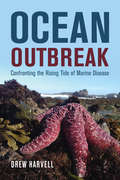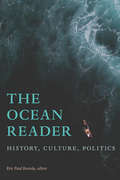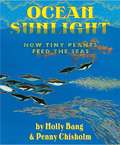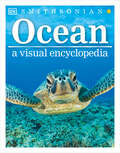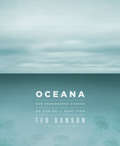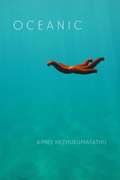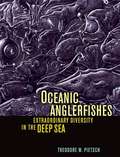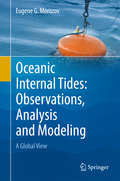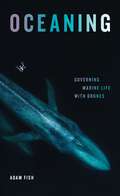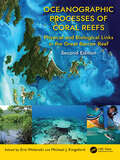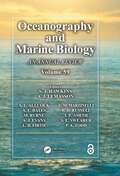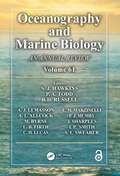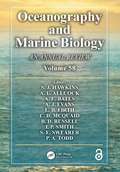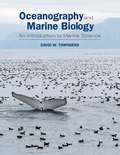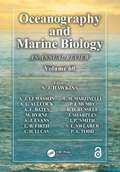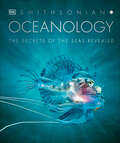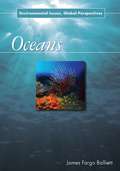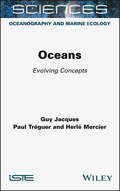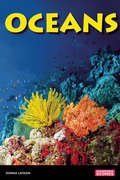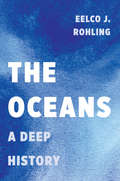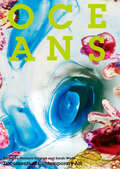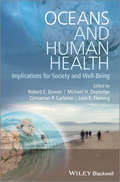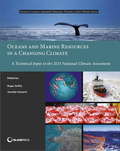- Table View
- List View
Ocean of Trade
by Pedro MachadoOcean of Trade offers an innovative study of trade, production and consumption across the Indian Ocean between the years 1750 and 1850. Focusing on the Vāniyā merchants of Diu and Daman, Pedro Machado explores the region's entangled histories of exchange, including the African demand for large-scale textile production among weavers in Gujarat, the distribution of ivory to consumers in Western India, and the African slave trade in the Mozambique channel that took captives to the French islands of the Mascarenes, Brazil and the Rio de la Plata, and the Arabian peninsula and India. In highlighting the critical role of particular South Asian merchant networks, the book reveals how local African and Indian consumption was central to the development of commerce across the Indian Ocean, giving rise to a wealth of regional and global exchange in a period commonly perceived to be increasingly dominated by European company and private capital.
Ocean Outbreak: Confronting the Rising Tide of Marine Disease
by Drew HarvellThere is a growing crisis in our oceans as rates of infectious disease outbreaks are on the rise. Marine epidemics have the potential to cause a mass die-off of wildlife from the bottom to the top of the food chain, impacting the health of ocean ecosystems as well as lives on land. Fueled by sewage dumping, unregulated aquaculture, and drifting plastic in warming seas, ocean outbreaks are sentinels of impending global environmental disaster. Ocean Outbreak follows renowned scientist Drew Harvell and her colleagues as they investigate how four iconic marine animals—corals, abalone, salmon, and starfish—have been devastated by disease. Based on over twenty years of research, this firsthand account of the sometimes creeping, sometimes exploding impact of disease on our ocean’s biodiversity ends with a hopeful message. Through policy changes and the implementation of innovative solutions from nature, we can reduce major outbreaks, save some ocean ecosystems, and protect our fragile environment.
The Ocean Reader: History, Culture, Politics (The World Readers)
by Eric Paul RoordaFrom prehistoric times to the present, the Ocean has been used as a highway for trade, a source of food and resources, and a space for recreation and military conquest, as well as an inspiration for religion, culture, and the arts. The Ocean Reader charts humans' relationship to the Ocean, which has often been seen as a changeless space without a history. It collects familiar, forgotten, and previously unpublished texts from all corners of the world. Spanning antiquity to the present, the volume's selections cover myriad topics including the slave trade, explorers from China and the Middle East, shipwrecks and castaways, Caribbean and Somali pirates, battles and U-boats, narratives of the Ocean's origins, and the devastating effects of climate change. Containing gems of maritime writing ranging from myth, memoir, poetry, and scientific research to journalism, song lyrics, and scholarly writing, The Ocean Reader is the essential guide for all those wanting to understand the complex and long history of the Ocean that covers over 70 percent of the planet.
Ocean Sunlight: How Tiny Plants Feed the Seas (Sunlight Series)
by Molly Bang Penny ChisholmIn this timely book, acclaimed Caldecott artist Molly Bang and award-winning M.I.T. professor Penny Chisholm use poetic language and dazzling illustrations to introduce the oceanic world. From tiny aquatic plants to the biggest whale or fish, Bang and Chisholm present a moving, living picture of the miraculous balance sustaining each life cycle and food chain deep within our wondrous oceans. <P><P>On land or in the deep blue sea, we are all connected--and we are all a part of a grand living landscape. Award-winning scientist Penny Chisholm, a leading expert on oceans, packs <i>Ocean Sunlight</i> with clear, simple science, illuminated by Molly Bang's wondrous illustrations. This informative, joyous book will help children understand and celebrate the astonishing role our oceans play in human life.
Ocean Sustainability in the 21st Century
by Salvatore AricòDescribing the emerging and unresolved issues related to the oceans and the marine environment, this book presents the developments made in marine science and policy since the implementation of the United Nations Convention on the Law of the Sea (UNCLOS), and implications for the sustainable management of ocean areas and resources. This comprehensive volume also provides a number of scientific, policy, and legal tools to address such issues, and to ensure better science-based management of the oceans. Topics covered include the impacts of human-induced climate change on the oceans, the marine genetic resources debate, the current legal framework for the oceans, and a comparative study of the legal issues associated with outer space. Including practical examples and worldwide case studies, this book is a valuable resource for policy makers, students and academics, in marine science and policy, ocean affairs, and the law of the sea.
Ocean: A Visual Encyclopedia (DK Children's Visual Encyclopedias)
by DK John WoodwardFrom the shimmering surface to the darkest depths, this breathtaking visual encyclopedia presents our blue planet as never before. Stunning photography, accessible information, and fascinating facts are spilling over in this essential guide to the oceans. Take a dip in all the world&’s waters to experience their incredible diversity. Make a splash in the icy Arctic waters before warming up in the tropical Indian Ocean. Experience the super size of mighty whales compared to swarms of tiny krill. Cast your eyes to the skies to see circling sea birds before diving down to meet mysterious creatures of the deep. Awash with comprehensive information and fascinating detail, Ocean: A Children&’s Encyclopedia is the perfect choice for school projects, marine enthusiasts, and water babies everywhere.
Oceana: Our Endangered Oceans and What We Can Do to Save Them
by Ted Danson Mike D'OrsoMost people know Ted Danson as the affable bartender Sam Malone in the long-running television series Cheers. But fewer realize that over the course of the past two and a half decades, Danson has tirelessly devoted himself to the cause of heading off a looming global catastrophe—the massive destruction of our planet's oceanic biosystems and the complete collapse of the world's major commercial fisheries. In Oceana, Danson details his journey from joining a modest local protest in the mid-1980s to oppose offshore oil drilling near his Southern California neighborhood to his current status as one of the world's most influential oceanic environmental activists, testifying before congressional committees in Washington, D.C.; addressing the World Trade Organization in Zurich, Switzerland; and helping found Oceana, the largest organization in the world focused solely on ocean conservation.In his incisive, conversational voice, Danson describes what has happened to our oceans in just the past half-century, ranging from the ravages of overfishing and habitat destruction to the devastating effects of ocean acidification and the wasteful horrors of fish farms. Danson also shares the stage of Oceana with some of the world's most respected authorities in the fields of marine science, commercial fishing, and environmental law, as well as with other influential activists.Combining vivid, personal prose with an array of stunning graphics, charts, and photographs, Ocean powerfully illustrates the impending crises and offers solutions that may allow us to avert them, showing you the specific courses of action you can take to become active, responsible stewards of our planet's most precious resource—its oceans.
Oceanic
by Aimee NezhukumatathilWith inquisitive flair, Aimee Nezhukumatathil creates a thorough registry of the earth’s wonderful and terrible magic. In her fourth collection of poetry, she studies forms of love as diverse and abundant as the ocean itself. She brings to life a father penguin, a C-section scar, and the Niagara Falls with a powerful force of reverence for life and living things. With an encyclopedic range of subjects and unmatched sincerity, Oceanic speaks to each reader as a cooperative part of the earth, an extraordinary neighborhood to which we all belong.
Oceanic Anglerfishes: Extraordinary Diversity in the Deep Sea
by Theodore W. PietschNo environment on Earth imposes greater physical and biological constraints on life than the deep oceanic midwaters. Near-freezing temperatures, the absence of sunlight, enormous pressure, and a low food supply make habitation by any living thing almost inconceivable. Yet 160 species of anglerfishes are found there in surprising profusion. Monstrous in appearance, anglerfishes possess a host of unique and spectacular morphological, behavioral, and physiological innovations. In this fully illustrated book, the first to focus on these intriguing fish, Theodore W. Pietsch delivers a comprehensive summary of all that is known about anglerfishes--morphology, diversity, evolution, geographic distribution, bioluminescence, and reproduction.
Oceanic Internal Tides: Observations, Analysis and Modeling
by Eugene G. MorozovThis book presents a detailed study of the structure and variability of internal tides and their geographical distribution in the ocean. Based on experimental analysis of oceanic measurements combined with numerical modeling, it offers a comprehensive overview of the internal wave processes around the globe. In particular, it is based on moored buoys observations in many regions in all oceans (Atlantic, Pacific, Indian, Arctic, and Southern) that have been carried out by researchers from different countries for more than 40 years as part of various oceanographic programs, including WOCE and CLIVAR. However, a significant portion of the data was collected by the author, who is a field oceanographer. The data was processed and interpreted on the basis of the latest knowledge of internal wave motion. The properties of internal waves were analyzed in relation to the bottom topography and mean state of the ocean in specific regions. Internal waves play a major role in the formation of seawater stratification and are responsible for the main processes of ocean dynamics, such as energy transfer and mixing. One of the most significant ideas presented in this book is the generation of internal tides over submarine ridges. Energy fluxes from submarine ridges related to tidal internal waves greatly exceed the fluxes from continental slopes. Submarine ridges form an obstacle to the propagation of tidal currents, which can cause the creation of large amplitude internal tides. Energy fluxes from submarine ridges account for approximately one fourth of the total energy dissipation of the barotropic tides. Model simulations and moored measurements have been combined to generate a map of global distribution of internal tide amplitudes. This book is of interest to oceanographers, marine biologists, civil engineers, and scientists working in climate research, fluid mechanics, acoustics, and underwater navigation.
Oceaning: Governing Marine Life with Drones (Elements)
by Adam FishDrones are revolutionizing ocean conservation. By flying closer and seeing more, drones enhance intimate contact between ocean scientists and activists and marine life. In the process, new dependencies between nature, technology, and humans emerge, and a paradox becomes apparent: Can we have a wild ocean whose survival is reliant upon technology? In Oceaning, Adam Fish answers this question through eight stories of piloting drones to stop the killing of porpoises, sharks, and seabirds and to check the vitality of whales, seals, turtles, and coral reefs. Drone conservation is not the end of nature. Instead, drone conservation results in an ocean whose flourishing both depends upon and escapes the control of technologies. Faulty technology, oceanic and atmospheric turbulence, political corruption, and the inadequacies of basic science serve to foil governance over nature. Fish contends that what emerges is an ocean/culture—a flourishing ocean that is distinct from but exists alongside humanity.
Oceanographic Processes of Coral Reefs: Physical and Biological Links in the Great Barrier Reef
by Eric Wolanski Michael J. KingsfordIn the last two decades since publication of the first edition, substantial advancements have been made in the science, the need for transdisciplinary approaches to coral reef protection greater than ever before. This new edition, now in full color throughout with accompanying animations, goes beyond identifying foundational information and current problems to pinpoint science-based solutions for managers, stakeholders and policy makers. Coral reefs are connected by currents that carry plankton and the larvae of many reef-based organisms. Further, they supply food to reefs. Currents also bring pollutants from the land and, together with the atmosphere, affect the surrounding ocean. The chapters in this book provide a much-needed review of the biophysics of reefs with an emphasis on the Great Barrier Reef as an ecosystem. The focus is on interactions between currents, waves, sediment and the dynamics of coastal and reef-based ecosystems. The topographic complexity of reefs redirects mainstream currents, creates tidal eddies, mushroom jets, boundary layers, stagnation zones, and this turbulence is enhanced by the oceanographic chaos in the adjoining Coral Sea. This is the environment in which particles and organisms, of a range of sizes live, from tiny plankton to megafauna. This generates faunal connectivity at scales of meters to thousands of km within the Great Barrier Reef and with the adjoining ocean. Pollution from land-use is increasing and remedial measures are described both on land and on coral cays. The impact of climate change is quantified in case studies about mangroves and corals. Modelling this biophysical complexity is increasing in sophistication, and the authors suggest how the field can advance further.
Oceanography and Marine Biology: An Annual Review, Volume 55 (Oceanography and Marine Biology - An Annual Review)
by S. J. HawkinsOceanography and Marine Biology: An Annual Review remains one of the most cited sources in marine science and oceanography. The ever-increasing interest in work in oceanography and marine biology and its relevance to global environmental issues, especially global climate change and its impacts, creates a demand for authoritative refereed reviews summarizing and synthesizing the results of recent research. If you are interested in submitting a review for consideration for publication in OMBAR, please email the Editor in Chief, Stephen Hawkins, at S.J.Hawkins@soton.ac.uk. For nearly 60 years, OMBAR has been an essential reference for research workers and students in all fields of marine science. This volume considers such diverse topics as the Great Barrier Reef Expedition of 1928-29, Mediterranean marine caves, macromedusae in eastern boundary currents, marine biodiversity in Korea, and development of a geo-ecological carbonate reef system model to predict responses of reefs to climate change. Seven of the peer-reviewed contributions in Volume 59 are available to read Open Access on this webpage (1, 2, 3, 4, 5, 6 and 9). An international Editorial Board ensures global relevance and expert peer review, with editors from Australia, Canada, Hong Kong, Ireland, Singapore and the United Kingdom. The series volumes find a place in the libraries of not only marine laboratories and oceanographic institutes, but also universities worldwide.
Oceanography and Marine Biology: An annual review. Volume 61 (Oceanography and Marine Biology - An Annual Review #61)
by S. J. Hawkins P. A. Todd B. D. Russell A. J. Lemasson A. L. Allcock M. Byrne L. B. Firth C. H. Lucas E. M. Marzinelli P. J. Mumby J. Sharples I. P. Smith S. E. SwearerOceanography and Marine Biology: An Annual Review remains one of the most cited sources in marine science. The increasing interest in work in oceanography and marine biology and its relevance to global environmental issues, especially global climate change and its impacts, creates a demand for authoritative refereed reviews summarising and synthesising the results of both historical and recent research. For more than 50 years, OMBAR has been an essential reference for researchers, students and workers in all fields of marine science. An international Editorial Board ensures global relevance and expert peer review, with editors from Australia, Hong Kong, Ireland, Singapore, and the UK. The series of volumes can be found in the libraries of institutes and universities worldwide. Five of the seven peer-reviewed contributions in Volume 61 are available to read Open Access via this webpage and on OAPEN. Supplementary material is provided online on the Support Materials tab on the book’s www.routledge.com webpage for Reviews 1, 2, 4, 5 and 6.. Volume 61 features a review of 100 years of daily sea surface temperature from the Hopkins Marine Station in Pacific Grove, California; an exploration of the biology and life cycle of enigmatic crustacean y-larvae; a review of the science, policy and management of the Central and South Atlantic Deep Sea benthos; a review of the biodiversity of the Irish-Scottish continental margin; an investigation of how new molecular tools can be used for marine biodiversity and ecosystem assessments, and a look at the resilience of marine organisms to climate change. A final monograph considers enemy shells as refugia from grazing and competition pressure. If you are interested in submitting a review for consideration for publication in OMBAR, please email the new co-Editors in Chief, Dr Peter Todd (dbspat@nus.edu.sg) and Dr Bayden Russell (brussell@hku.hk). Guidelines for contributors to OMBAR, including information on illustration requirements, can be downloaded on the "Support Material" tab on the latest volume’s webpage.
Oceanography and Marine Biology: An annual review. Volume 58 (Oceanography and Marine Biology - An Annual Review #58)
by S. J. Hawkins, A. L. Allcock, A. E. Bates, A. J. Evans, L. B. Firth, C. D. McQuaid, B. D. Russell, I. P. Smith, S. E. Swearer, and P. A. ToddOceanography and Marine Biology: An Annual Review remains one of the most cited sources in marine science and oceanography. The ever-increasing interest in work in oceanography and marine biology and its relevance to global environmental issues, especially global climate change and its impacts, creates a demand for authoritative refereed reviews summarizing and synthesizing the results of recent research. For more than 50 years, OMBAR has been an essential reference for research workers and students in all fields of marine science. If you are interested in submitting a review for consideration for publication in OMBAR, please email the Editor in Chief, Stephen Hawkins, at S.J.Hawkins@soton.ac.uk. This volume considers such diverse topics as optimal design for ecosystem-level ocean observatories, the oceanography and ecology of Ningaloo, human pressures and the emergence of novel marine ecosystems and priority species to support the functional integrity of coral reefs. Six of the nine peer-reviewed contributions in Volume 58 are available to read Open Access via the links on the Routledge.com webpage. An international Editorial Board ensures global relevance and expert peer review, with editors from Australia, Canada, Hong Kong, Ireland, Singapore, South Africa and the United Kingdom. The series volumes find a place in the libraries of not only marine laboratories and oceanographic institutes, but also universities worldwide. Chapters 1, 2, 3, 4, 5, 7, and 8 of this book are freely available as downloadable Open Access PDFs at http://www.taylorfrancis.com under a Creative Commons Attribution-Non Commercial-No Derivatives (CC-BY-NC-ND) 4.0 license.
Oceanography and Marine Biology: An Introduction to Marine Science
by David W. TownsendOceanography and Marine Biology preserves the basic elements of the physical, chemical, and geological aspects of the marine sciences, and merges those fundamentals into a broader framework of marine biology and ecology. Existing textbooks on oceanography or marine biology address the companion field only cursorily: very few pages in oceanography texts are devoted to marine biology, and vice versa. This new book overcomes that imbalance, bringing these disparate marine science text formats closer together, giving them more equal weight, and introducing more effectively the physical sciences by showing students with everyday examples how such concepts form the foundation upon which to build a better understanding of the marine environment in a changing world. Lecturer supplements will also be available.
Oceanography and Marine Biology: An Annual Review, Volume 60 (Oceanography and Marine Biology - An Annual Review #60)
by S. J. HawkinsOceanography and Marine Biology: An Annual Review remains one of the most cited sources in marine science and oceanography. The ever-increasing interest in work in oceanography and marine biology and its relevance to global environmental issues, especially global climate change and its impacts, creates a demand for authoritative refereed reviews summarizing and synthesizing the results of both historical and recent research. This Volume celebrates 60 years of OMBAR, over which time it has been an essential reference for research workers and students in all fields of marine science. The peer-reviewed contributions in Volume 60 are available to read Open Access via this webpage and on OAPEN. If you are interested in submitting a review for consideration for publication in OMBAR, please email the Editor-in-Chief, Stephen Hawkins (S.J.Hawkins@soton.ac.uk) for Volume 61. For Volume 62 onwards, please email the new co-Editors in Chief, Dr Peter Todd (dbspat@nus.edu.sg) and Dr Bayden Russell (brussell@hku.hk). Volume 60 features an editorial on the UN Decade of Ocean Science and goes on to consider such diverse topics as Cenozoic tropical marine biodiversity, blue carbon ecosystems in Sri Lanka, marine litter and microplastics in the Western Indian Ocean, and the ecology and conservation status of the family Syngnathidae in southern and western Africa. This volume also contains a retrospective Prologue on the evolution of OMBAR and pays tribute to one of its early Editors in Chief, Margaret Barnes, by providing an update on her review in OMBAR of the stalked barnacle Pollicipes. Supplementary online videos as well as additional Tables and Appendices are available on the Support Tab of the book's Routledge webpage. An international Editorial Board ensures global relevance and expert peer review, with editors from Australia, Canada, Hong Kong, Ireland, Singapore and the UK. The series volumes find a place in the libraries of not only marine laboratories and oceanographic institutes, but also universities worldwide.
Oceanology: The Secrets of the Sea Revealed (DK Secret World Encyclopedias)
by DKDive into this uniquely elegant visual exploration of the sea An informative and utterly beautiful introduction to marine life and the ocean environment, Oceanology brings the riches of the underwater world onto the printed page.Astounding photography reveals an abundance of life, from microscopic plankton to great whales, seaweed to starfish. Published in association with the Smithsonian Institution, the book explores every corner of the oceans, from coral reefs and mangrove swamps to deep ocean trenches. Along the way, and with the help of clear, simple illustrations, it explains how life has adapted to the marine environment, revealing for example how a stonefish delivers its lethal venom and how a sponge sustains itself by sifting food from passing currents. It also examines the physical forces and processes that shape the oceans, from global circulation systems and tides to undersea volcanoes and tsunamis.To most of us, the marine world is out of reach. But with the help of photography and the latest technology, Oceanology brings us up close to animals, plants, and other living things that inhabit a fantastic and almost incomprehensibly beautiful other dimension.
Oceans: Environmental Issues, Global Perspectives
by James Fargo BalliettCovering 71 percent of the planet, these saline bodies of water provided the unique conditions necessary for the building blocks of life to form billions of years ago. This book explains how our oceans continue to support and influence life in important ways: by providing the largest global source of protein in the form of fish populations, by creating and influencing weather systems, and by absorbing waste streams such as airborne carbon. It is shown how oceans have an almost magnetic draw—almost half of the world’s population lives within a few hours of an ocean. Although oceans are vast in size, exceeding 328 million cubic miles (1.37 billion cubic kilometers), they have been influenced by and have influenced humans in numerous ways. The book includes three detailed case studies. The first focuses on the most remote locations along the Mid-Atlantic Ridge, where new ocean floor is being formed twenty-thousand feet underwater. The second considers the Maldives, a string of islands in the Indian Ocean, where increasing sea levels may force residents to abandon some communities by 2020. The third describes the North Sea at the edge of the Arctic Ocean, where fishing stocks have been dangerously depleted as a result of multiple nations’ unrelenting removal of the smallest and largest species.
Oceans: Evolving Concepts (Ioc Ocean Forum Ser.)
by Guy Jacques Paul Tréguer Herlé MercierSince the HMS Challenger expedition of 1872–1876, our vision of the ocean has changed completely. We now understand that it plays a key role in biodiversity, climate regulation, and mineral and biological resources, and as such, the ocean is a major service provider for humanity. Oceans draws on data from new oceanographic and satellite tools, acquired through international interdisciplinary programs. It describes the processes that control how the ocean functions, on different spatial and temporal scales. After considering the evolution of concepts in physical, chemical and biological oceanography, the book outlines the future of a warmer, acidified, less oxygenated ocean. It shows how a view of the ocean at different scales changes how we understand it. Finally, the book presents the challenges facing the ocean in terms of the exploitation of biological and mineral resources, in the context of sustainable development and the regulation of climate change.
Oceans
by Donna LathamInvestigating the planet's biomes and examining the modern threats to each ecosystem, this interactive series challenges young readers to look at how their own actions affect the planet's health. With compare-and-contrast facts and vocabulary-building sidebars, each engaging guide reveals how environmental threats-both human and natural-affect plants and animals.Detailing the largest biome, this guide surveys the environmental threats to the earth's oceans. Teaching students about coral reefs-the rainforests of the ocean-this educational resource explores topics such as the connection between increasing levels of carbon dioxide in the atmosphere and the bleaching of the reefs. By comparing the size of an island of floating plastic and other trash in the middle of the Pacific Ocean to the state of Texas-and how that floating island impacts ocean life-the guide shows young environmentalists why consuming less plastic is important.
The Oceans: A Deep History
by Eelco J. RohlingThe 4.4-billion-year history of the oceans and their role in Earth's climate systemIt has often been said that we know more about the moon than we do about our own oceans. In fact, we know a great deal more about the oceans than many people realize. Scientists know that our actions today are shaping the oceans and climate of tomorrow—and that if we continue to act recklessly, the consequences will be dire. In this timely and accessible book, Eelco Rohling traces the 4.4 billion-year history of Earth’s oceans while also shedding light on the critical role they play in our planet’s climate system.Beginning with the formation of primeval Earth and the earliest appearance of oceans, Rohling takes readers on a journey through prehistory to the present age, vividly describing the major events in the ocean’s evolution—from snowball and greenhouse Earth to the end-Permian mass extinction, the breakup of the Pangaea supercontinent, and the changing climate of today. Along the way, he explores the close interrelationships of the oceans, climate, solid Earth processes, and life, using the context of Earth and ocean history to provide perspective on humankind’s impacts on the health and habitability of our planet—and on what the future may hold for us.An invaluable introduction to the cutting-edge science of paleoceanography, The Oceans enables you to make your own informed opinions about the environmental challenges we face as a result of humanity’s unrelenting drive to exploit the world ocean and its vital resources.
Oceans (Whitechapel: Documents of Contemporary Art)
by Pandora Syperek Sarah WadeOCEANS attends to the inextricable human and nonhuman agencies that affect and are affected by the sea and its running currents within contemporary art and visual culture.Oceans cover more than 70 percent of the Earth&’s surface, dividing and connecting humans, who carry saltwater in their blood, sweat and tears. They also represent a powerful nonhuman force, rising, flooding, heating and raging in unprecedented ways as the climate crisis unfolds. Artists have envisioned the sea as a sublime wilderness, home to mythical creatures and bizarre species, a source of life and death, a site of new beginnings and tragic endings, both wondrous and disastrous. From migration to melting ice caps, the sea is omnipresent in international news and politics, leaking into popular culture and proliferating in recent art and exhibitions. This anthology gathers artists and writers to address the ocean not only as a theme but as a major agent of artistic and curatorial methods.Artists surveyed includeBas Jan Ader, Eileen Agar, John Akomfrah, Heba Y. Amin, Shuvinai Ashoona, Betty Beaumont, Leopold & Rudolf Blaschka, Heidi Bucher, Marcus Coates, Tacita Dean, Chris Dobrowolski, Léuli Eshrāghi, Ellen Gallagher, Ayesha Hameed, Barbara Hepworth, Klara Hobza, Isuma, Brian Jungen, Tania Kovats, Sonia Levy, Armin Linke, Lani Maestro, Ana Mendieta, Kasia Molga, Eleanor Morgan, Wangechi Mutu, Saskia Olde Wolbers, Jean Painlevé and Geneviève Hamon, Allan Sekula, Shimabuku, Ahren Warner, Christine & Margaret Wertheim, Alberta WhittleWriters include Stacy Alaimo, Bergit Arends, Erika Balsom, Karen Barad, Rachel Carson, Mel Y. Chen, T.J. Demos, Marion Endt-Jones, Kodwo Eshun, Paul Gilroy, Stefano Harney, Epeli Hau&’ofa, Donna Haraway, Eva Hayward, Stefanie Hessler, Luce Irigaray, Zakiyyah Iman Jackson, Celina Jeffery, Melody Jue, Max Liboiron, Lana Lopesi, Chus Martínez, Jules Michelet, Fred Moten, Astrida Neimanis, Celeste Olalquiaga, Ralph Rugoff, John Ruskin, Marina Warner, Jan Verwoert
Oceans and Human Health
by Robert E. Bowen Michael H. Depledge Lora E. Fleming Cinnamon P. CarlarneHuman health and well-being are tied to the vitality of the global ocean and coastal systems on which so many live and rely. We engage with these extraordinary environments to enhance both our health and our well-being. But, we need to recognize that introducing contaminants and otherwise altering these ocean systems can harm human health and well-being in significant and substantial ways.These are complex, challenging, and critically important themes. How the human relationship to the oceans evolves in coming decades may be one of the most important connections in understanding our personal and social well-being. Yet, our understanding of this relationship is far too limited.This remarkable volume brings experts from diverse disciplines and builds a workable understanding of breadth and depth of the processes - both social and environmental - that will help us to limit future costs and enhance the benefits of sustainable marine systems. In particular, the authors have developed a shared view that the global coastal environment is under threat through intensified natural resource utilization, as well as changes to global climate and other environmental systems. All these changes contribute individually, but more importantly cumulatively, to higher risks for public health and to the global burden of disease.This pioneering book will be of value to advanced undergraduate and postgraduate students taking courses in public health, environmental, economic, and policy fields. Additionally, the treatment of these complex systems is of essential value to the policy community responsible for these questions and to the broader audience for whom these issues are more directly connected to their own health and well-being."The seas across this planet and their effects on human society and its destiny are a fascinating subject for analysis and insights derived from intellectual inquiry. This diverse and complex subject necessarily requires a blending of knowledge from different disciplines, which the authors of this volume have achieved with remarkable success.""The following pages in this volume are written in a lucid and very readable style, and provide a wealth of knowledge and insightful analysis, which is a rare amalgam of multi-disciplinary perspectives and unique lines of intellectual inquiry. It is valuable to get a volume such as this, which appeals as much to a non-specialist reader as it does to those who are specialists in the diverse but interconnected subjects covered in this volume."(From the "Foreword" written by, R K Pachauri, Director General, TERI and Chairman, IPCC)
Oceans and Marine Resources in a Changing Climate
by Roger Griffis Jennifer HowardPrepared for the 2013 National Climate Assessment and a landmark study in terms of its breadth and depth of coverage, Oceans and Marine Resources in a Changing Climate is the result of a collaboration among numerous local, state, federal, and nongovernmental agencies to develop a comprehensive, state of the art look at the effects of climate change on the oceans and marine ecosystems under U. S. jurisdiction. This book provides an assessment of scientific knowledge of the current and projected impacts of climate change and ocean acidification on the physical, chemical, and biological components and human uses of marine ecosystems under U. S. jurisdiction. It also provides assessment of the international implications for the U. S. due to climate impacts on ocean ecosystems and of efforts to prepare for and adapt to climate and acidification impacts on ocean ecosystem, including · Climate-Driven Physical and Chemical Changes in Marine Ecosystems · Impacts of Climate Change on Marine Organisms · Impacts of Climate Change on Human Uses of the Ocean · International Implications of Climate Change · Ocean Management Challenges, Adaptation Approaches, and Opportunities in a Changing Climate · Sustaining the Assessment of Climate Impacts on Oceans and Marine Resources Rich in science and case studies, it examines the latest climate change impacts, scenarios, vulnerabilities, and adaptive capacity and offers decision makers and stakeholders a substantial basis from which to make informed choices that will affect the well-being of the region's inhabitants in the decades to come.

